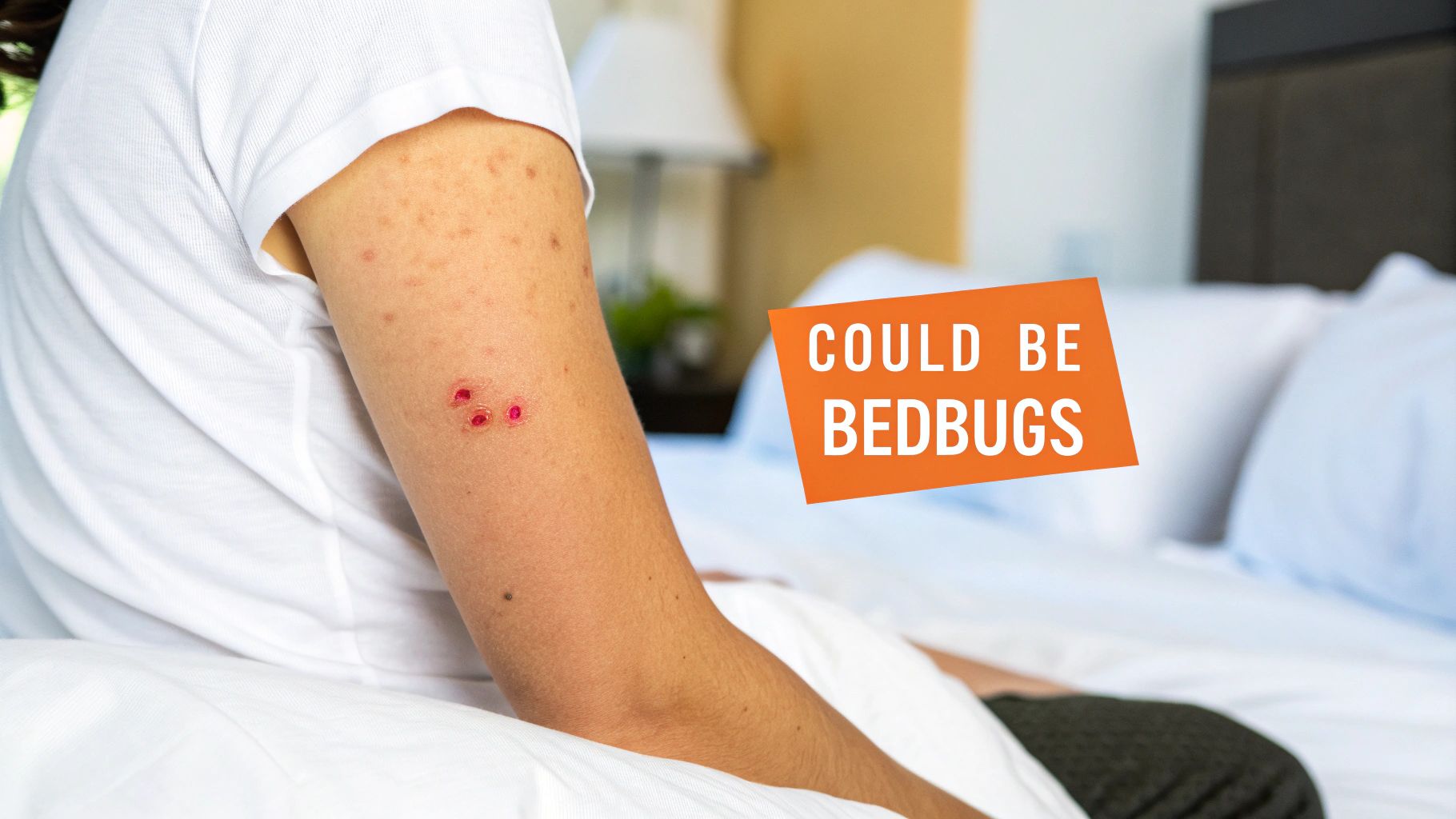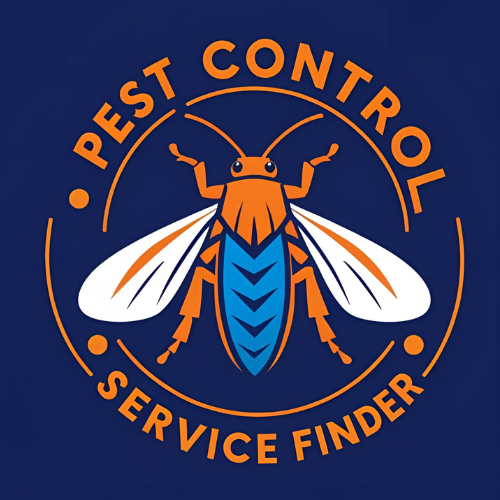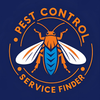How to Check for Bed Bugs: A Step-by-Step Guide

You might think a clean house is safe. Bed bugs don't care. They just need blood. It's that simple. Even the cleanest homes get them.
So, how do you check for bed bugs? You need a good plan. Look at your mattress seams. Check the box spring. Inspect the bed frame. You are looking for live bugs. You are also looking for dark spots and tiny skins. A flashlight and a credit card are your best tools. These pests love to hide in tiny cracks.
If you suspect you have bed bugs, don't wait. A quick check now can save you a lot of trouble later. If you need help, you can always call +1 855 224 3071 to talk to a professional.
That Itchy Spot Might Not Be a Mosquito

You wake up with a red, itchy mark on your arm. Your first thought is probably a mosquito, or maybe even a spider. We all tend to brush off these little irritations, but the real culprit could be hiding just inches from where you sleep.
A lot of people think bed bugs only show up in dirty homes, but that’s one of the biggest myths out there. These pests are expert hitchhikers and can find their way into even the cleanest, most immaculate spaces.
Waiting around is the worst thing you can do. A few bugs can explode into a major infestation, which makes getting rid of them much harder and more expensive. A quick, thorough check can save you a ton of stress and money. If you’re worried and want an expert opinion right away, don't wait. Call +1 855 224 3071 to connect with a specialist who can help.
The Modern Bed Bug Problem
Decades ago, finding bed bugs was pretty rare in most parts of the world. But since the 1980s, they've made a dramatic comeback globally, reversing a decline that began way back in the 1930s. This resurgence is tied to things like more international travel, growing resistance to insecticides, and changes in pest control strategies that just aren't as effective against them anymore. You can learn more about the epidemiology of bed bugs and their resurgence for a deeper dive.
What this means for you is that anyone can get bed bugs. They aren't just in cheap motels; they're found in five-star hotels, luxury apartments, and single-family homes. Their knack for hiding in tiny cracks and surviving for months without a meal makes them incredibly tough survivors.
A single pregnant female bed bug can lead to an infestation of over 5,000 bed bugs in just six months under the right conditions. This explosive growth is exactly why finding them early is so important.
What You Are Looking For
Before you start tearing your room apart, you need to know exactly what you're trying to find. A successful inspection is all about spotting the subtle clues they leave behind.
- Live Bugs: Adult bed bugs are small, flat, and oval-shaped with a reddish-brown color. They're about the size of an apple seed.
- Fecal Spots: These look like tiny black ink dots, often found in clusters where the bugs hang out. If you touch them with a wet cloth, they'll smear.
- Shed Skins: As young bed bugs (called nymphs) grow, they molt and leave their old skins behind. These are translucent, bug-shaped casings and are a sure sign of an active problem.
- Eggs: Bed bug eggs are tiny (about 1mm), pearly white, and extremely hard to spot. They're usually laid in tight seams and hidden crevices.
Recognizing these signs is the first step in knowing how to check for bed bugs like a pro. If you find any of this evidence and feel overwhelmed, a professional can confirm what you're seeing. Call +1 855 224 3071 for immediate help.
Gearing Up: Your Bed Bug Inspection Toolkit
You don't need a truck full of expensive, high-tech gear to hunt for bed bugs. The truth is, a good inspection is more about being thorough than having fancy equipment. You probably have everything you need lying around the house right now.
Getting a few simple items together before you start makes the whole process smoother and a lot more effective. If you get stuck or find something that makes you uneasy, don't hesitate to call an expert for advice at +1 855 224 3071.
The Essentials for Your Hunt
Your main job is to get a clear look into all the dark, tight hiding spots bed bugs love. These simple tools are perfect for the job.
- A Bright LED Flashlight: Sure, your phone light works in a pinch, but a real, high-powered flashlight is way better. It'll let you peer deep into mattress seams, behind headboards, and into the dark corners of a bed frame where these pests retreat.
- A Stiff Card: An old credit card, a gift card, even a library card will do. You'll use this to slide along seams and poke into tight crevices, forcing out any hidden bugs, eggs, or shed skins you'd otherwise miss.
- A Magnifying Glass: This might sound like overkill, but it's not. Bed bug eggs are tiny—about the size of a pinhead—and the newly hatched nymphs are nearly transparent. A magnifying glass helps you know for sure if you're looking at an egg or just a stray piece of lint.
A pest control pro’s first move is almost always a detailed visual check, and they're usually just using a powerful flashlight and their own two eyes. These basic tools are what we rely on.
As you get your gear ready, now is also a good time to think about the advantages of a mattress protector. They not only keep your mattress clean but make future inspections a whole lot easier. Just remember, these tools are for finding bed bugs, not treating them. Spraying the wrong chemicals can make the problem worse and be dangerous—our guide to finding a safe indoor insect spray explains what to look for.
With your simple toolkit in hand, you’re ready to start the search. Be patient, be methodical, and check everywhere. If your inspection confirms your fears, remember you don't have to face it by yourself. Call +1 855 224 3071 for immediate help.
Your Meticulous Bedroom Inspection Guide
The bedroom is almost always ground zero for bed bug activity, which is why your inspection has to start here. This is where you’ll spend the most time, so a systematic search is non-negotiable. Think of yourself as a detective at a crime scene—you're looking for subtle clues, not just the culprits themselves.
Start with the most obvious spot: the mattress. Carefully strip off all the bedding, including sheets, pillowcases, and blankets. You'll need to inspect these items later, but set them aside for now and focus on the bare mattress. Pay extremely close attention to the seams, tufts, piping, and any tags or labels.
This graphic shows the simple but essential tools you'll need to turn a quick glance into a detailed investigation.

Each tool helps you uncover evidence that the naked eye would easily miss.
Tackling the Mattress and Box Spring
Grab your flashlight and shine it directly along every single inch of the mattress seams. A great trick I use is to run a credit card or a thin, stiff piece of plastic along these edges to push out anything hiding just inside the fold.
Here’s exactly what you’re hunting for:
- Live Bugs: Adult bed bugs are reddish-brown and about the size of an apple seed. Nymphs are smaller and translucent.
- Dark Fecal Spots: These look like someone dotted the fabric with a black fine-tip marker. They often appear in clusters along seams and will smear if you wipe them with a damp cloth.
- Shed Skins (Casings): As young bed bugs grow, they molt, leaving behind hollow, translucent casings that look just like the bug itself.
- Tiny White Eggs: These are the hardest to spot. They’re pearly white, about 1mm long, and usually clustered in tight, protected crevices.
After thoroughly checking the top, bottom, and all four sides of the mattress, it's time to move to the box spring. Bed bugs absolutely love the dark, undisturbed environment inside a box spring. Check its seams and where the fabric is stapled to the wooden frame underneath—a prime hiding spot.
If you find definitive proof here and feel overwhelmed, professional help is just a call away. Call +1 855 224 3071 for immediate expert assistance from a local pro.
Moving to the Bed Frame and Headboard
Once the mattress and box spring are cleared, your focus shifts to the structure holding them up. The bed frame and headboard offer countless nooks and crannies for bed bugs to hide. If you can, take the bed frame apart to inspect every joint, screw hole, and crack.
Bed bugs are thigmotactic, which is a fancy way of saying they prefer tight spaces where their bodies are touching surfaces on all sides. This is why joints in a metal bed frame, cracks in a wooden headboard, and the tiny gap behind a wall-mounted headboard are so attractive to them.
The best inspections combine a systematic visual search with a solid understanding of bed bug behavior. These pests are nocturnal, feeding at night and hiding during the day in places just like these. You can discover more insights about their biology and inspection methods to understand exactly why they hide where they do.
Pay special attention to where the headboard attaches to the wall or bed frame. Shine your light into every gap. If you find anything suspicious and decide it’s time for a professional to take over, you can always call +1 855 224 3071 for a rapid response.
Bed Bug Hotspot Inspection Guide
To make things easier, I've put together a quick-reference table. It covers the most common hiding spots around the bed and what signs to look for in each. Use this as your checklist to make sure you don't miss a thing.
| Location | What to Look For | Inspection Tip |
|---|---|---|
| Mattress Seams & Tufts | Black fecal spots, shed skins, tiny white eggs, live bugs | Run a credit card along the seams to force out hidden bugs or eggs. |
| Box Spring (underside) | Clusters of black spots, live bugs, casings near staples & corners | Flip it over. Peel back the stapled fabric (the dust cover) to inspect the interior wood frame. |
| Bed Frame Joints & Screws | Live bugs and fecal stains tucked into corners and screw holes | If possible, disassemble the frame to get a clear view of all connection points. |
| Headboard (front & back) | Dark spotting, shed skins, especially where it meets the wall or frame | Use a flashlight to check the gap between the headboard and the wall—a major hotspot. |
| Bedding & Pillowcases | Small blood stains (rust-colored), fecal spots, live bugs | Inspect pillow seams and the folds of sheets and blankets before washing them in hot water. |
This table should help you stay organized and methodical. A thorough inspection is your best first defense, giving you the information you need to decide on your next steps.
Searching For Bed Bugs Beyond The Bed
Don't be fooled by a clean mattress. Finding nothing there doesn't mean you're in the clear—in fact, it can sometimes mean the infestation is well-established and spreading. As a bed bug population explodes, they're forced to find new hiding spots in places you'd never think to look.
This is exactly why just checking the bed is a rookie mistake. If you’ve given the mattress a thorough look-over and come up empty, it’s time to expand the search. Knowing how to hunt for bed bugs across the entire room is the only way to understand the true scale of the problem you might be facing.
Inspecting Your Upholstered Furniture
First up: couches, armchairs, and any other upholstered furniture. These pieces are just as appealing to bed bugs as a mattress, offering plenty of dark crevices and easy access to a human host. Use the same methodical approach you did with your bed.
- Pull all the cushions off and check every single seam, zipper, and fabric tuft.
- Flip the entire piece of furniture over. Inspect the underside, focusing on the frame, joints, and anywhere fabric is stapled to the wood.
- Use your flashlight to peer deep inside the frame's hidden voids and cracks.
Bed bugs will cram themselves into the absolute tightest spaces available, so a quick glance won't cut it. Use your stiff card to dig into seams and flush out anything hiding inside. If you find something that looks suspicious, take a clear photo and call +1 855 224 3071 for a professional opinion.
Uncovering Less Obvious Hiding Spots
With the main furniture checked, you need to start thinking like a bed bug. A mature infestation means they'll be hiding in some truly surprising places throughout the room.
Take your time and methodically check these common but easily missed hotspots:
- Behind Wall Hangings: Carefully lift picture frames, mirrors, and even clocks off the wall. Check the back of the item itself and the wall area it was covering for fecal spots or live bugs.
- Along Baseboards: Get down on your hands and knees. Shine your flashlight along the gap where the baseboard meets both the floor and the wall.
- Inside Electrical Outlets: Do not stick anything into the outlet slots. Instead, carefully unscrew the faceplate and remove it to inspect the empty space behind it.
- Curtains and Drapes: Check all the folds, seams, and hems. Pay special attention to the top where the fabric bunches up along the curtain rod.
A huge mistake people make is assuming bed bugs stay in one room. They absolutely will travel to adjacent rooms, especially in apartments or condos. The source of your problem could easily be coming from a neighbor.
This ability to spread is a massive challenge in dense urban areas. Cities like New York and Chicago constantly battle major bed bug problems, amplified by apartment living and frequent travel that helps these pests hitchhike from one building to the next. You can learn more about why certain cities are hotspots for bed bugs on microbe-investigations.com.
As you conduct a full search of your home, using a comprehensive property inspection checklist can also help you spot other potential pest issues and maintenance needs. A meticulous inspection is your best weapon. If you start finding signs of a widespread problem, don't wait. Call +1 855 224 3071 to get connected with a licensed exterminator right away.
What to Do After Finding Evidence

Finding something that looks like bed bug evidence can make your stomach drop. Your first instinct is probably to grab the nearest cleaner, start scrubbing, or even drag the mattress to the curb. Stop. The absolute best first move is to do nothing at all.
That's right—don't disturb the area. Spraying a store-bought bug killer or even just vacuuming can backfire badly. It causes bed bugs to panic and scatter, fleeing deeper into your walls or escaping to other rooms. This can turn a small, contained problem into a widespread infestation that’s much harder for a professional to treat.
Instead of reacting with panic, take a breath. Your next steps need to be calm and methodical, starting with documenting what you've found.
Document and Confirm Your Findings
Before you move a single thing, pull out your phone. Take clear, well-lit photos of whatever you found. A blurry, dark picture of a tiny speck isn't going to help anyone, so get as close as you can while keeping the image sharp and in focus.
This evidence is gold for a few key reasons:
- Expert Confirmation: When you call a professional, a clear photo is the next best thing to them being there. Call +1 855 224 3071, and you can describe exactly what you're seeing, helping them understand the situation immediately.
- Avoiding False Alarms: It’s incredibly easy to mistake other things for bed bugs. Carpet beetle larvae, booklice, and even little bits of dark lint can look suspicious. Good photos let you compare your findings against reliable reference images online.
A confirmed sign is something undeniable, like a live bug you've captured, a cluster of dark fecal spots smeared into a mattress seam, or a pile of translucent shed skins. A single, unidentified dark spot on a sheet could be anything from a pen mark to a crumb.
If you managed to find a live bug, carefully use a piece of clear tape to trap it. Stick the tape onto a plain white piece of paper. This is the perfect way to preserve it for an expert to identify later.
Why DIY Treatments Are a Bad Idea
With photos in hand, the urge to "just handle it" yourself can be overwhelming. But this is one pest where DIY solutions almost always fail and frequently make things much, much worse.
Most over-the-counter sprays and foggers are completely ineffective. Many bed bug populations have built up a strong resistance to the chemicals in these products. Worse, these sprays won’t get into the deep cracks, crevices, and wall voids where the real heart of the infestation is hiding. You might kill a few bugs crawling on the surface, but the core colony will survive, reproduce, and continue to spread.
The single most important step you can take is to get a professional assessment. A licensed exterminator has the training, experience, and proper tools to confirm the infestation, figure out how far it has spread, and build a treatment plan that actually works.
Preparing your home for their arrival is a critical step for success. Our guide on how to prepare for pest control will walk you through exactly what you need to do. For a definitive solution, Call +1 855 224 3071 right away.
Common Bed Bug Inspection Questions
So you've finished your initial search. Right now, you might be feeling relieved, completely confused, or even more stressed than when you started. That’s perfectly normal. After an inspection, a lot of questions usually pop up.
Many people figure one check is all it takes, but that's rarely true. Bed bugs are incredible hiders, and a single once-over might not reveal the full picture, especially if an infestation is brand new. Let’s tackle some of the most common questions people ask.
Can I See Bed Bugs with My Naked Eye
Yes, you definitely can. While they are small, adult bed bugs aren't microscopic. A full-grown adult is about the size of an apple seed (1/4 inch long) with a flat, oval body that’s reddish-brown. If you're looking carefully, you can spot them moving.
The real challenge comes with the younger bugs, known as nymphs. They are much smaller and can be almost translucent before they've fed, making them blend in easily. The eggs are even worse—about the size of a pinhead and pearly white, they're nearly impossible to spot on light-colored sheets or mattresses. This is a huge reason why you have to look for all the other signs, like fecal spots and shed skins.
If you find something and you're not 100% sure what it is, don't guess. Call +1 855 224 3071 to get a professional opinion right away.
Do Bed Bug Bites Always Appear in a Line
This is one of the biggest myths out there, and it's not a reliable sign at all. The classic "breakfast, lunch, and dinner" pattern—a neat line of three bites—can happen, but it's far from a rule.
The truth is, everyone reacts differently to bed bug bites. Here’s what you need to know:
- Some people have zero reaction and will never show a single mark.
- Others might get large, itchy welts that look just like mosquito bites.
- Bites can also show up in random clusters or as single, scattered marks.
Relying on bite marks alone to confirm an infestation is a huge mistake. So many people misidentify them. A physical inspection for the actual bugs and their signs is the only way to be absolutely certain.
How Quickly Can an Infestation Spread
Terrifyingly fast. A single pregnant female can lay between one and five eggs per day, which can explode into a massive population in just a couple of months. If you don't treat it, they'll spread from the first hiding spot (usually your bed) to other furniture, and eventually, into nearby rooms.
In apartments, condos, or any multi-unit building, they travel easily between units through wall voids, around pipes, and along electrical wiring. This rapid growth is exactly why you need to act immediately. If you find even one confirmed bug, it's safest to assume there are plenty more you haven't found. Acting fast makes all the difference, and it's helpful to understand just how stubborn they are. You can read more about what pros say about getting rid of roaches vs bed bugs for more perspective on that.
When the stakes are this high, expert help isn't just an option—it's a necessity. Call +1 855 224 3071 to connect with a vetted professional who can figure out the scope of the problem and create a solid treatment plan.
When you need a fast, reliable solution for a potential bed bug problem, turn to Pest Control Service Finder. We connect you with local, licensed exterminators 24/7 for a no-obligation quote. Don't let uncertainty turn into a full-blown infestation—get professional help today at https://pestcontrol-service-finder.com.

